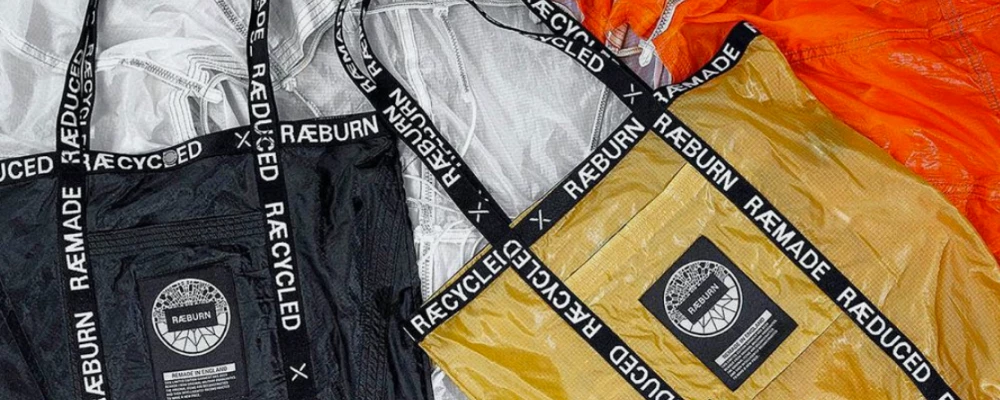
How To Extend The Life Of Your Materials
We often in the sustainable fashion realm discuss and act on extending the life of clothing, however this negates all of the other materials leftover from production, or from products not necessarily associated with garments, yet are just as pliable.
In this article, we take a look at why we should extend the life of our materials, along some favourite playful designers who are showing the possibilities with material "upcycling". We also have an update on the finalists of our #LockdownStash Challenge that saw makers imaginatively use on-hand materials to create a functional everyday item.
Sustainability in design requires a systems-based approach, meaning that we have to rethink our infrastructure, our habits and perceived value of materials, if we are to build a fully economically, socially and environmentally sustainable world.
If we take product design, and in particular Dutch or Danish aesthetics, you'll find a lot of "off the peg" materials not usually associated with high quality furniture, such as plywood and cardboard. And yet, by understanding the properties of such materials, these product designers are able to creatively flip our habits to allow for familiar though unusual materials into our spaces.
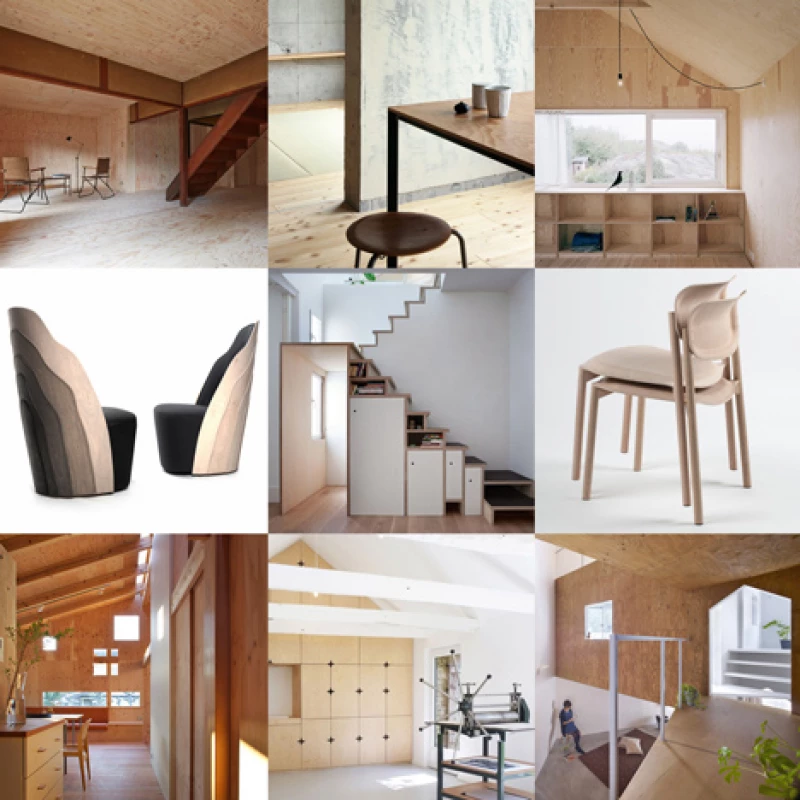
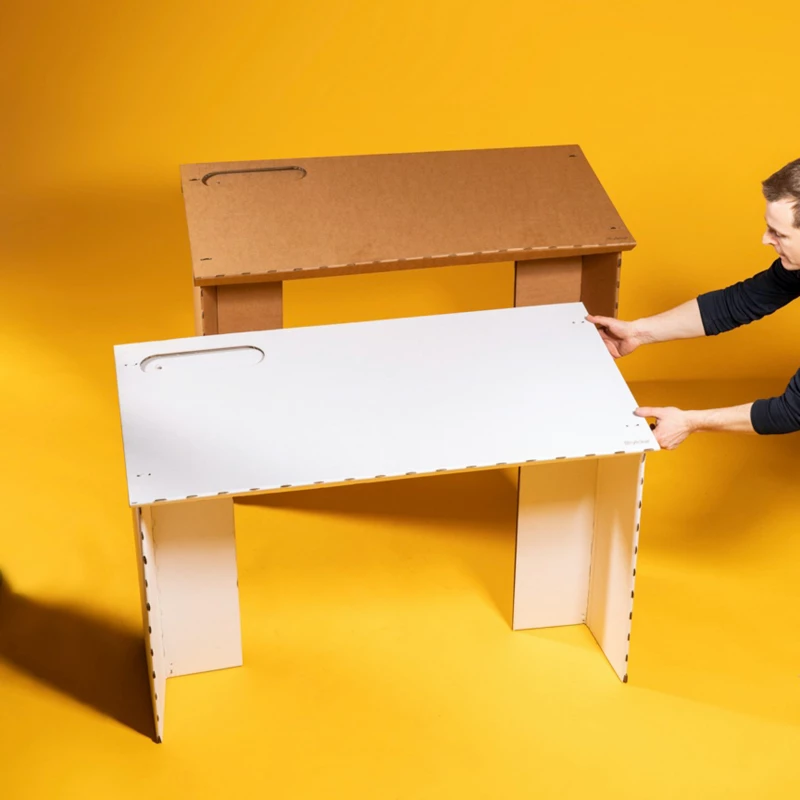
Fashion design mostly cannot be this exotic, because at the basic level, clothing is there to offer protection from the elements and warmth. If we start using materials that do not give a comforting feeling, we aren't likely to use it. So despite the fact that fashion denotes trends passing in and out, "fashion" design is actually just the same fundamental materials in different forms and colours.
Bootlegging was a term related to, in history, the transportation of illegal alcoholic drinks, but in recent times has come to mean the act of using materials and branding in witty manners. It is in this way that we can see a playfulness of materials not usually associated with fashion or in an unintended form, so read on as we look at some favourites.
Nicole McLaughlin
Using sportswear and outdoorwear, Nicole bootlegs the unwanted items into alternative pieces, from bags that become shoes, to hats that become tops. She also plays with everyday food items like sweet packets and bags of cereal. It shows that you can find function in the unlikeliest of places by looking at the base materials.
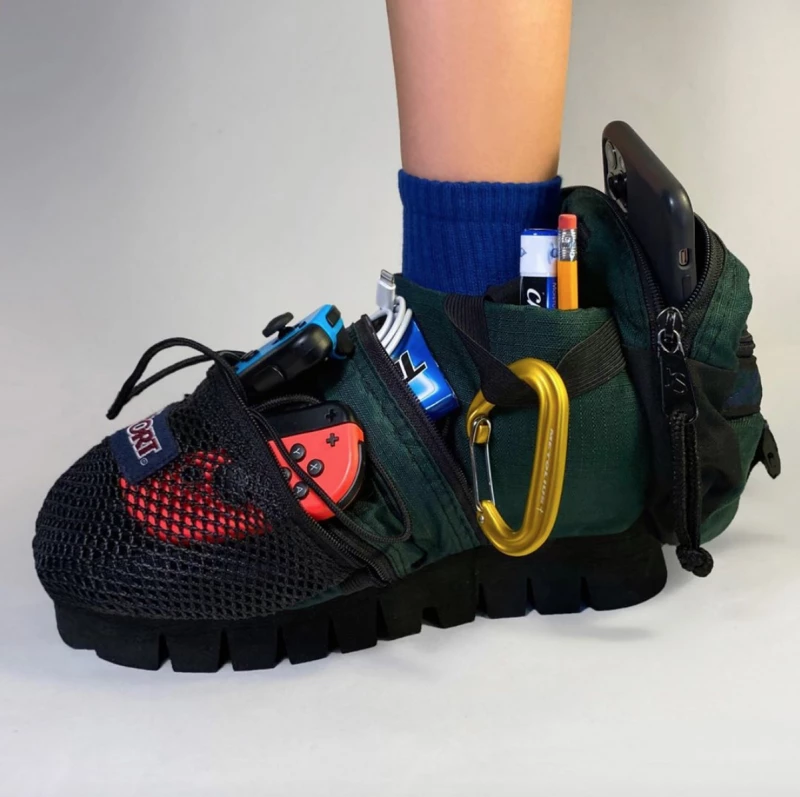
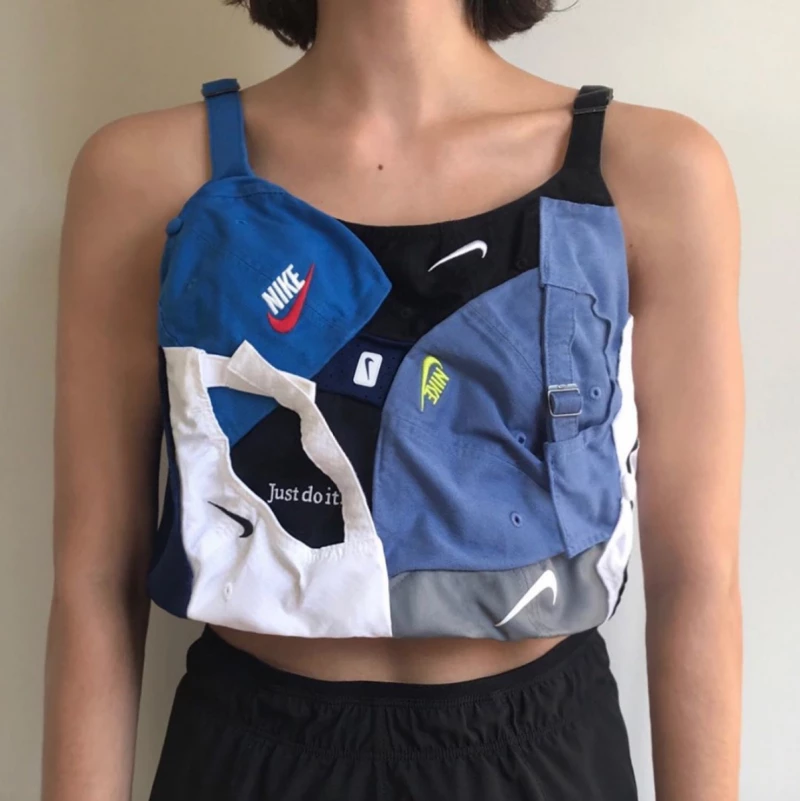
Bode
Utilising vintage tablecloths, napkins and blankets, Bode refreshes the textiles by creating unique clothing, primarily in the form of jackets and shirts. Even going further with the marketing over pandemic lockdown, her garden has become a photoshoot space and 'e-commerce' store.
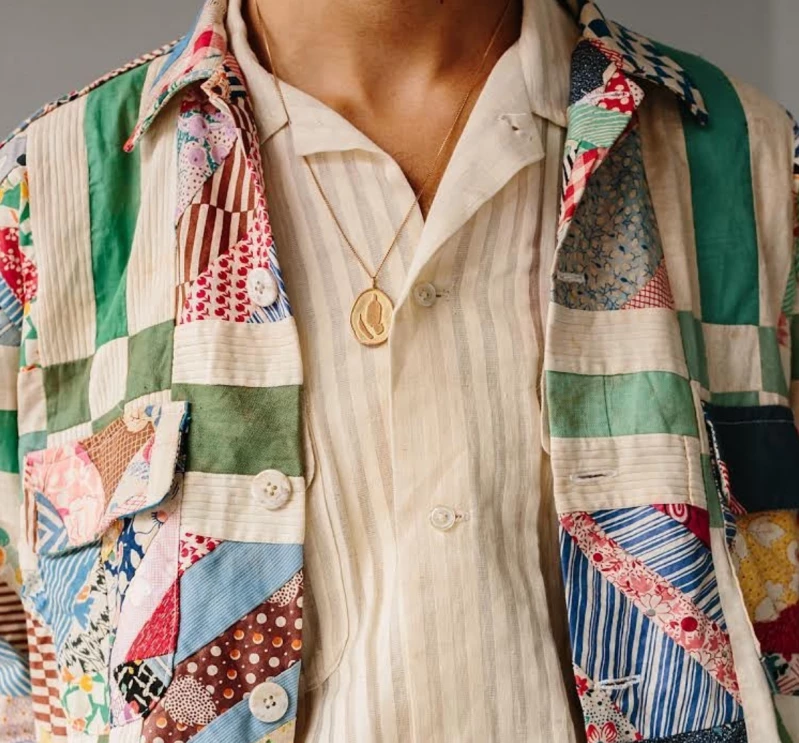
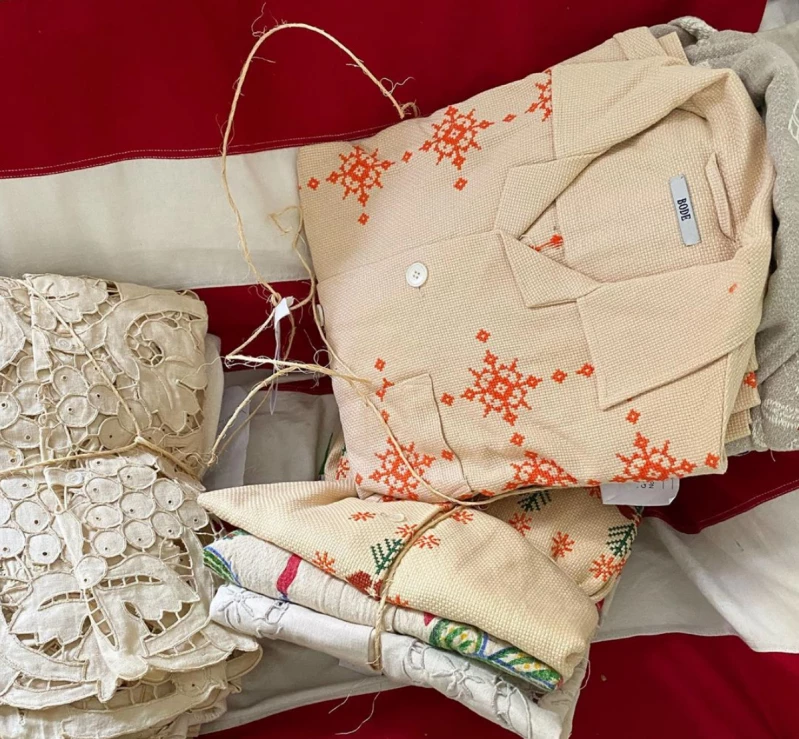
Christopher Raeburn
Probably a name you'll likely have come across, Christopher Raeburn has been using decommissioned parachutes to create clothing and accessories for many years. In fact, Christopher was doing this when I was saving festival tents to create clothing from as part of an MA project.
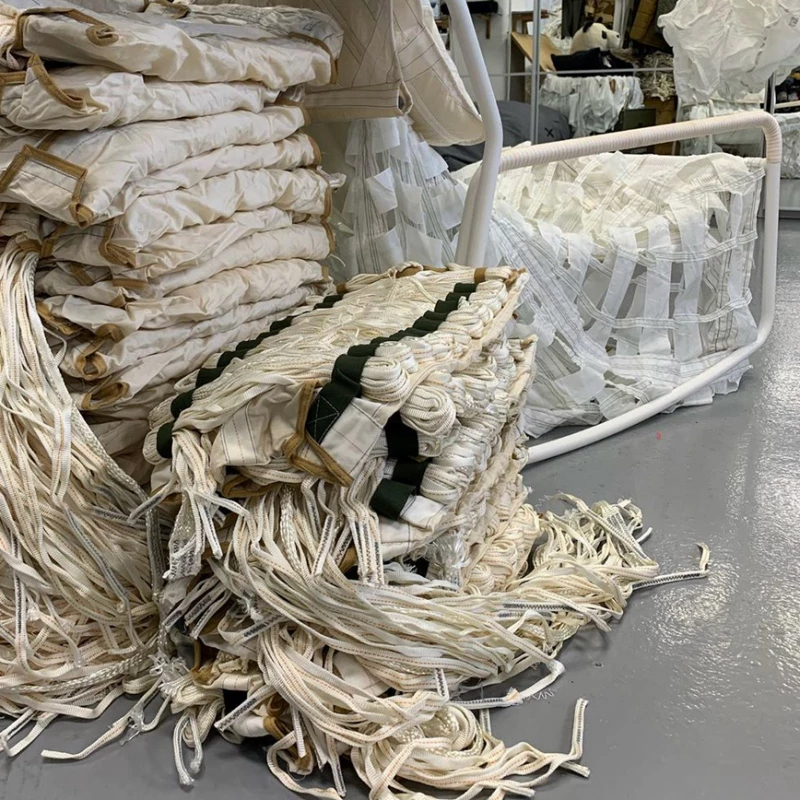
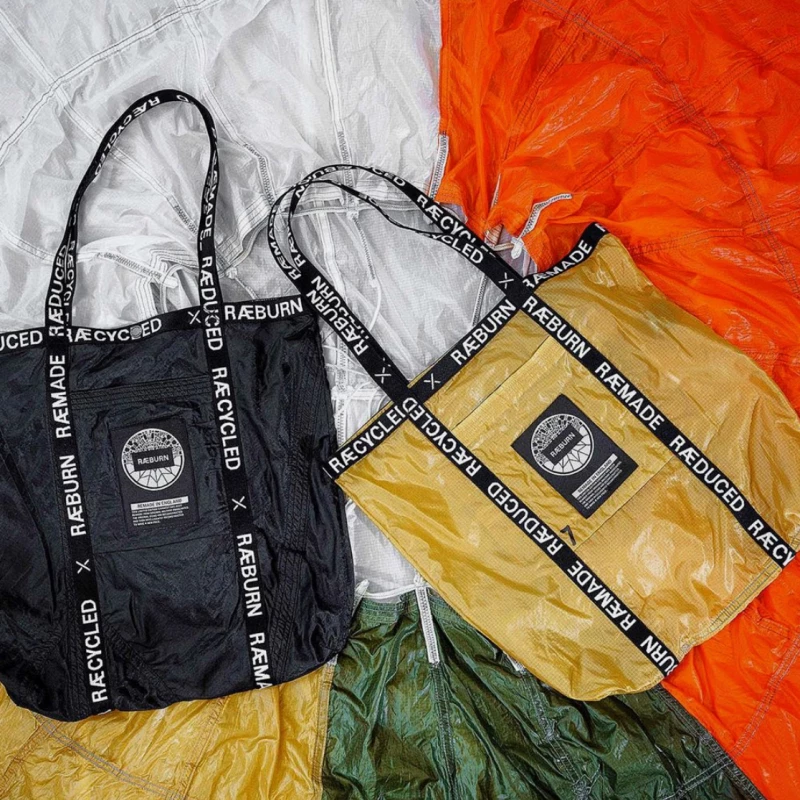
ReRun Clothing
Based on the south coast of England, ReRun are campaigning against the wasteful running industry who give our finishers t-shirts whether you request one or not, including it in the often extortionate race entry prices. There has been a surge in runners both discarding this excess, and refusing the t-shirts in the first place. It's an aspect of the textile recycling industry that is hardly considered, but if you've ever been to a mass-participation race you'll have seen the piles of clothing pre-race used as warm up clothing. So it isn't just the t-shirts and trainers that need to be considered. However, it's a wonderful starting point and here ReRun have been producing new playful items out of the old.
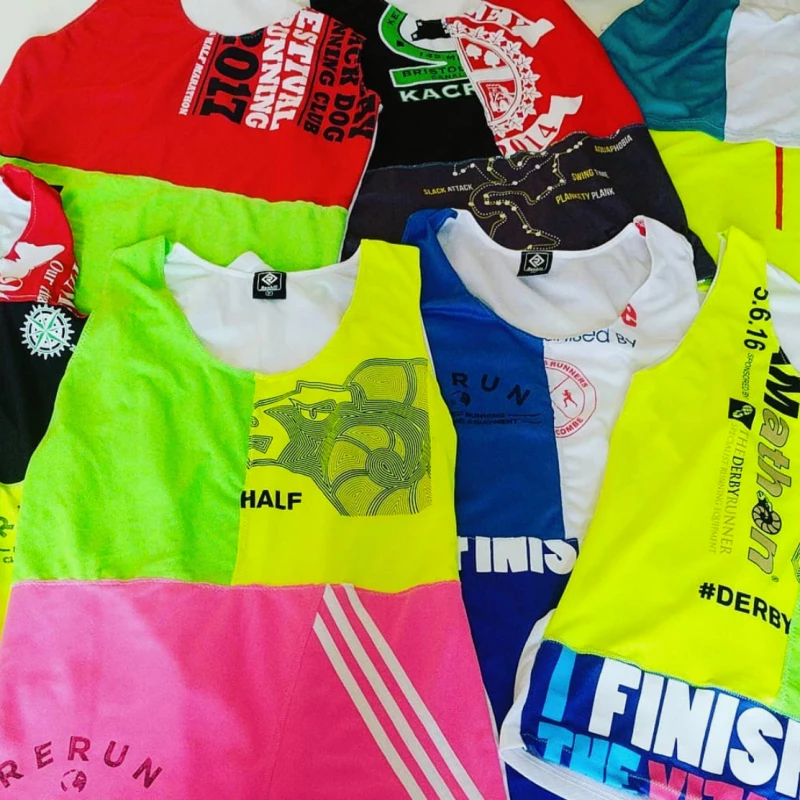
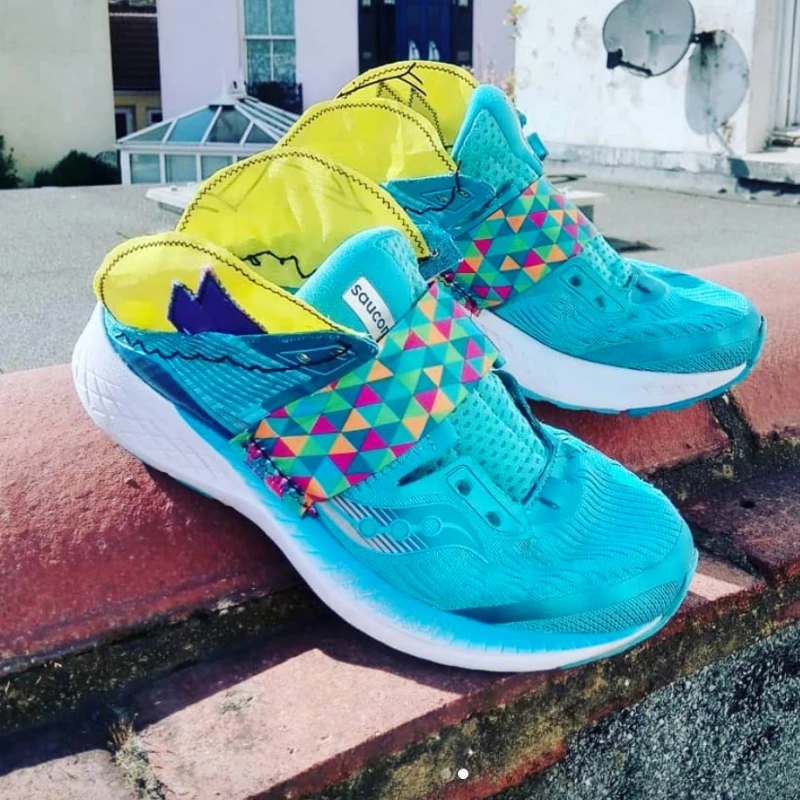
Heavier duty materials that will never be comfortable as a coat, could however be utilised for the less malleable of our items, such as bags and accessories. It is in this space that we see designers excel with found or discarded materials that would otherwise go to landfill. We have so much textile waste - according to WRAP,
it is estimated £140 million worth of clothing goes into landfill each year
- though this only looks at soft fabric items. Non-textile items that include mattresses, carpets and leisure items like tents are also heavily discarded, with WRAP providing guidance to industries on how these good condition materials can be re-used.
I'm the type of designer who uses found materials for the sheer joy of experimentation, not least because they're free, but because there are secret stories embedded too. Woollen army blankets, an airbed, fisherman rope, picture hooks, festival tents... they've all been utilised for clothing and fastening components. Definitely avant garde, but by combining soft and hard materials that are familiar to me, it provoked a sensation of homeliness within the garment shape - and because the materials are fairly ubiquitous, it is likely others would feel the same too.
We're coming to the end of UK's lockdown for the COVID-19 pandemic, and through this time we have been following how designers, brands and businesses have been productively utilising their time to not only prepare for more uncertainty ahead, but using what materials and resources were on hand at home when unable to access their studios and team. We wonder if collections for SS21 will be created using a patchwork and plethora of materials, or even if there will be season collections at all. In confined spaces, we become more observant and look closely at what is around us, a feeling of gratitude for whatever exists (tinged with a sensation of Groundhog Day).
Elvis and Kresse
In this situation, we saw you leap in to our Lockdown Stash Challenge with vigour, figuring out what functional item you required, and what materials you had on hand to create it with. We partnered with Elvis and Kresse for this sewing challenge, a business that produces luxury accessories and home furnishings from repurposed fire hoses and leather offcuts. They are sympathetic to the life of the material, effective with the pairing of first life to second life, and manage everything authentically and transparently.
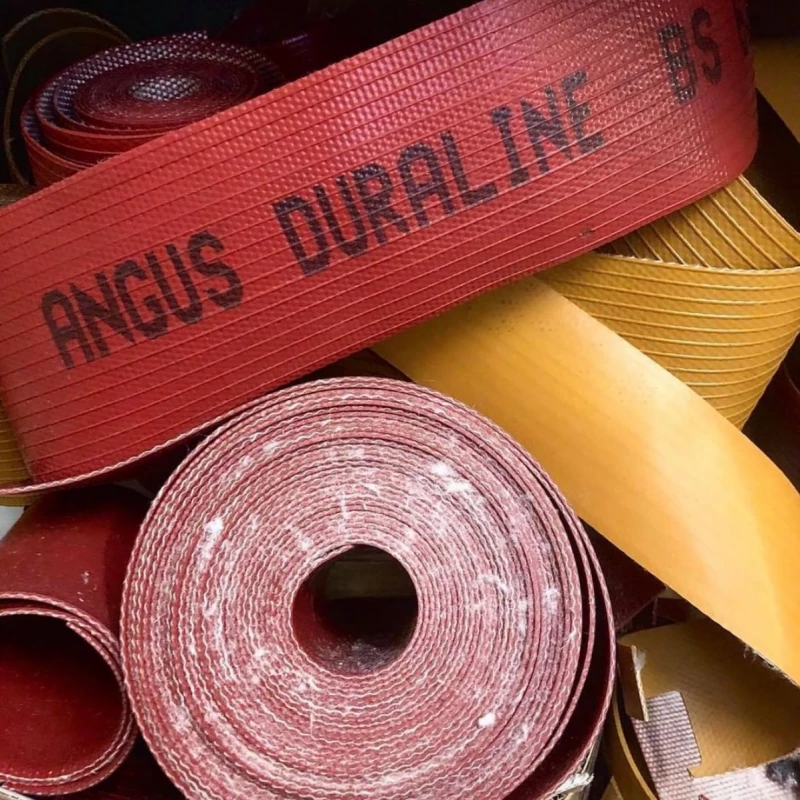
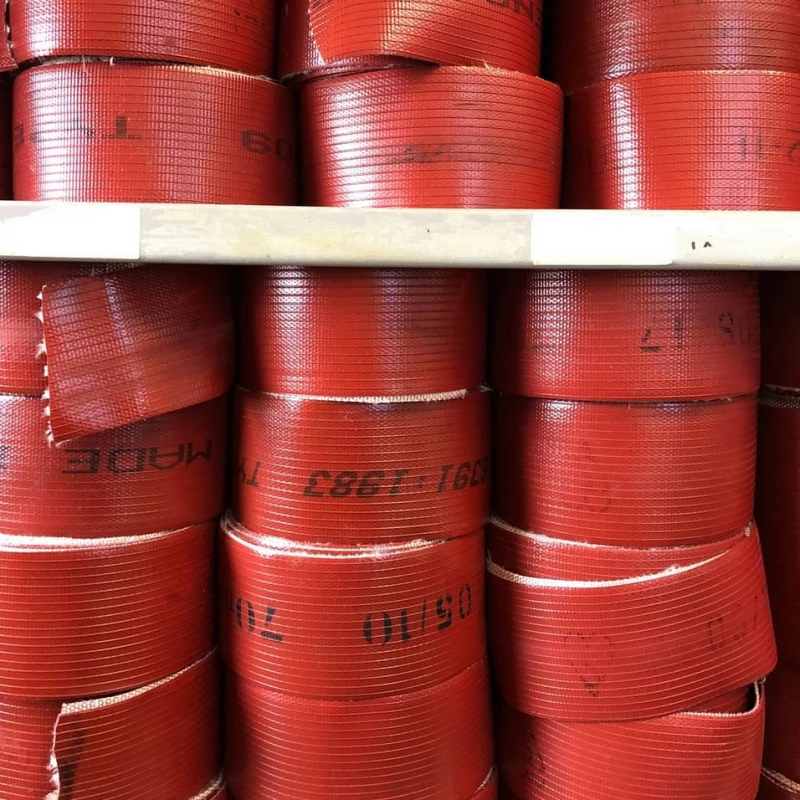
From Elvis and Kresse: "For over 100 years, Angus Fire has been making hose and there has been a manufacturing facility in Bentham, North Yorkshire for over 200 years. The nylon used for the hose is woven on site, then the rubber's constituent parts are ordered in and mixed up from a rather secret blend of raw materials. The nylon is then blown open while the warm, gum-like rubber is extruded through and around the woven core. This is an incredibly slow process as the rubber is cured and molded under pressure while it happens. The fire-hose is then tested before it is rolled and sent to brigades all over the world". An incredibly durable material, once decommissioned, it still has the ability to be made into something not needed for life-saving, yet still dramatic.
Read on for the finalists from our Lockdown Stash sewing challenge, who created wonderful objects from everyday materials at home.
#LockdownStash Challenge Finalists
On judging the many entries, Elvis and Kresse said,
We always look at adding value and longevity. How can we take something, and add value to it? How can we give this material the longest possible second life and can we extend this even further if we can take it apart again in the future?
They said it was tough to judge because there was some great ideas they loved that didn't quite stick to the brief, but eventually they came to the conclusion that Rebecca was the overall clear winner. This was due to sticking to the brief, the materials used, the conversations brought out and the educational message with it. "Great reuse and reusable!"
Rebecca Evans-Merritt @revansmerritt
"Did you know that your average disposable menstrual pad contains 90% plastic? Normal tampons contain plastic too! Working towards #plasticfreeperiods is important considering how many menstrual products are still flushed down toilets (2bn a year)." For this project, Rebecca used an old towel, t-shirts, a pair of cotton boxers and cotton fabric from her stash to make a variety of absorbent layers. Using a waterproof crib sheet as the middle PUL layer was ingenious - friends Plastic Free Hackney have used broken umbrella nylon for theirs.
Also made while on lockdown out of on-hand materials were these dish scrubbers (or #unsponges) ready to replace her last well worn set and also to give as gifts. Using up cotton scrap fabric, some old towels and hessian in her fabric stash, Rebecca made some quilted-style sponges with handy hanging loops to dry them out. Going further to consider the life cycle, Rebecca separated her scraps to use only white fabric for stuffing so they wouldn't show through when wet! Cotton thread was also used meaning the sponges can be composted once worn out.

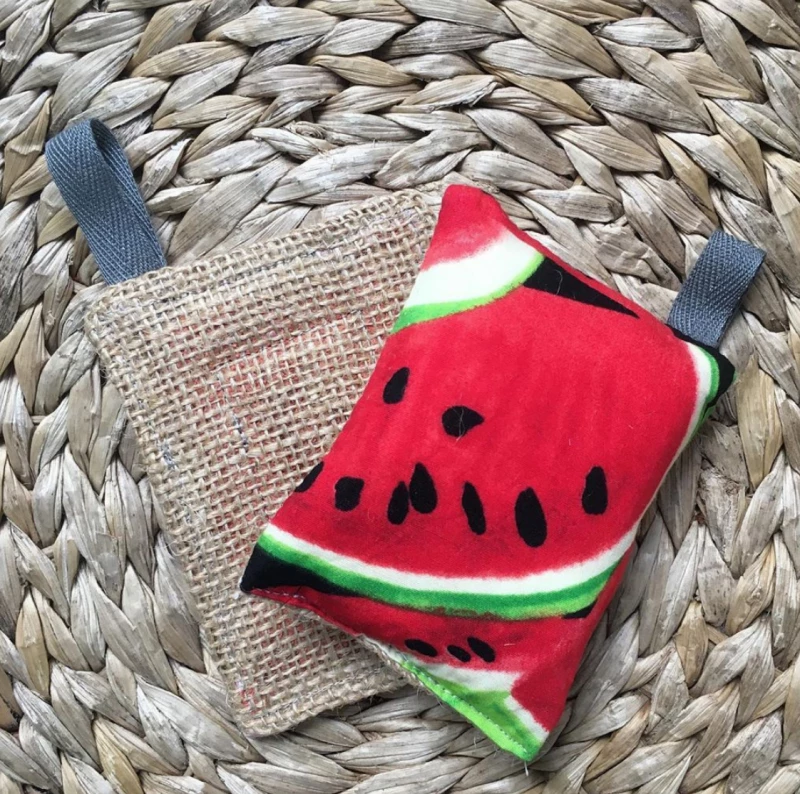
Q: Why does extending the life of materials matter to you?
A: There are many things problematic for people and the environment with the way lots of materials are produced nowadays, especially with the rise of disposable/throwaway culture. I think it's really important to have a connection to the things we buy and own, and for us to live as responsible consumers. This means taking care of our possessions, and trying to reuse things as much as we can.
"Extending the life of things that have already been manufactured shows appreciation for the original growers/makers and the world we live in that has given us the resources."
Q: How does this value sit in your everyday life?
A: I really worry about things ending up as landfill, and always try to take a moment to consider before throwing things in the bin. If I think I can find a use for something, I will keep it until I do! As someone who sews, I make sure to sort my scrap material by fibre content, so it can be re-used in a way that will reduce harm to the planet, so plastic materials aren't ending up back in the environment. I cherish what I own and like to fix things and buy secondhand as much as possible rather than buy new. If we can take the time to think about our waste, try to reduce how much waste we personally produce and try to extend how long we use things, it will really make a difference to the world we live in.
Suyamba Kumaresan @suyambakumaresan
Bespoke tailor and designer, Suyamba is just finishing her BA (Hons) Bespoke Tailoring degree at London College of Fashion. For her LockdownStash challenge entry, she created a tailor's ham using offcut tweed and brushed cotton with a very stuffed inner of fabric scraps from organic cotton calico toiles and denim makes. Elvis and Kresse said,
"This piece is something simple and timeless we can see will last and can easily be repaired or re-stuffed if needed, taken apart and put back together again."
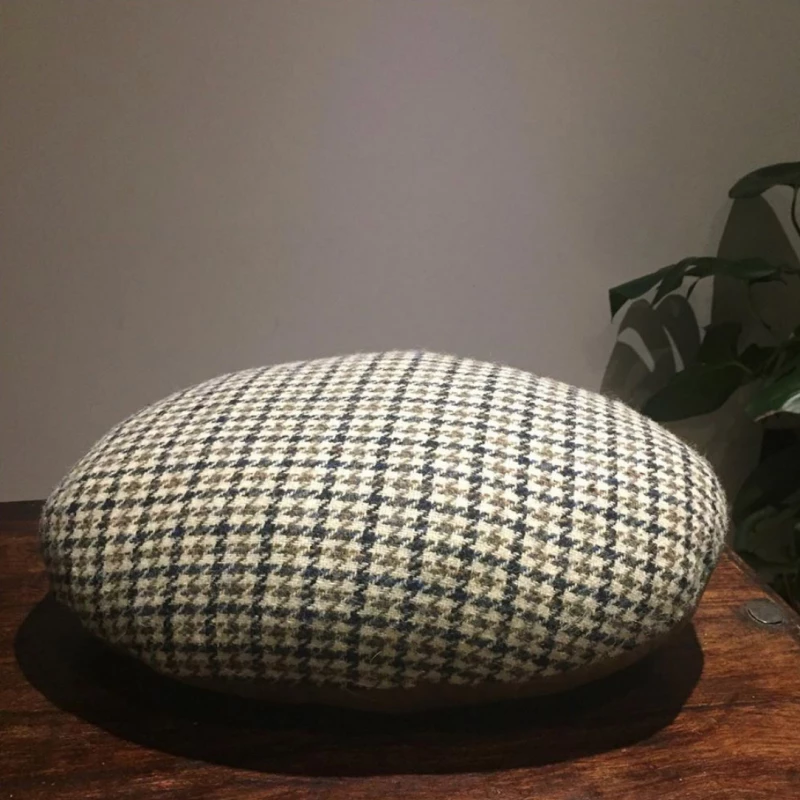
Q: Why does extending the life of materials matter to you?
A: From a Bespoke Tailoring perspective, this value is fundamental as the garments are made to fit well, with additional room hidden inside seams (in the form of inlay) to accommodate figure changes, and they are made beautifully with thought and care to ensure durability. This is actually a key value that drew me to bespoke tailoring in the first place.
The theme of extending the life of materials and projects goes hand-in-hand with a zero waste lifestyle - something I am striving for in both personal and professional areas: I use my production offcuts as filler for cushions (or Tailor's Hams!) after snipping it down to small pieces and use my pattern cutting card offcuts as swing tags/labels.
Ultimately, extending the life of materials matters to me as it is a core part of being sustainably-minded and is a wonderful "old-fashioned" approach to how we treat, maintain and care for our possessions. It cultivates a beautiful relationship and adds longevity to products.
Q: How does this value sit in your everyday life and also in your design work?
In my everyday life extending the life of materials and projects sits as part of a more holistic approach that considers the consequences of my available choices. Our current consumption choices have a very real and immediate effect on the people living all around the world right now, in addition to, the people of future generations to come. Extending the life of materials and projects is one of the many ways I can reduce my consumption and thus the strain I place on our global system. Since this is a core value in my personal life, it is a value that is synonymous with my professional life also.
Melody Munro @melo_vardo
Taking the pattern from a worn out dog collar, Melody created a new one using an old pair of ripped-beyond-repair jeans that had been placed in her fabric stash, along with some offcuts of leather, an old broken belt and a D-ring in her "bits and bobs" tin (we all have one of those surely).
Elvis and Kresse particularly loved the accessory's function, use of materials and we personally appreciate the entrepreneurial spirit of it too.

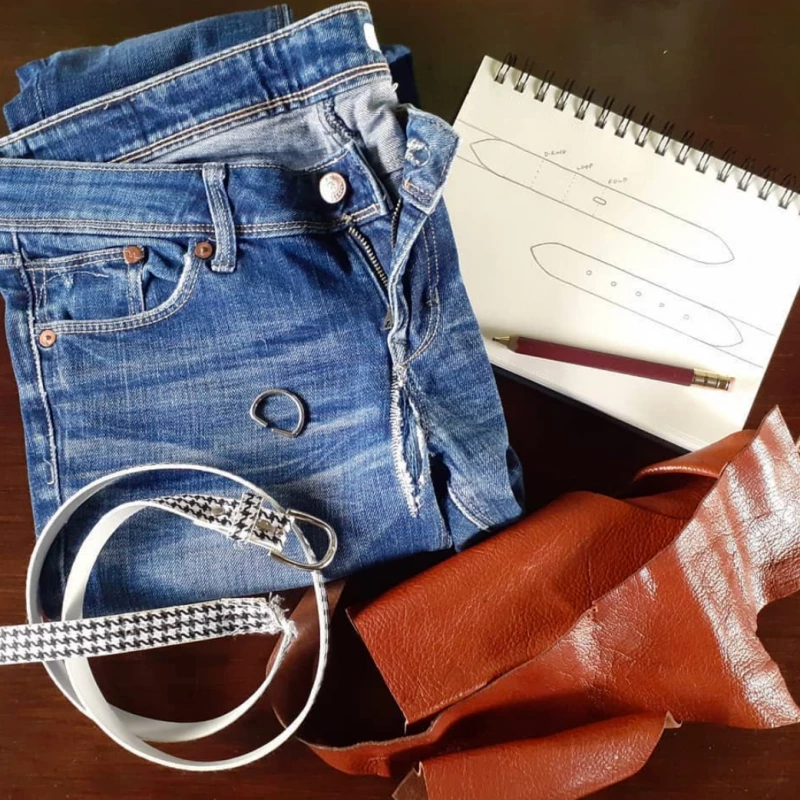
Anna Watson @annawatsonfashion
Anna had already made a full outfit from this red satin fabric in her stash (top, shorts, bralette, bag and scrunchie) and then continued the creativity into a pair of satin slippers that finished the outfit off. What's wonderful is she used a discarded camping mat from her garage and quilt wadding to make them super cosy. We particularly love the blanket stitching that keeps the pieces together.
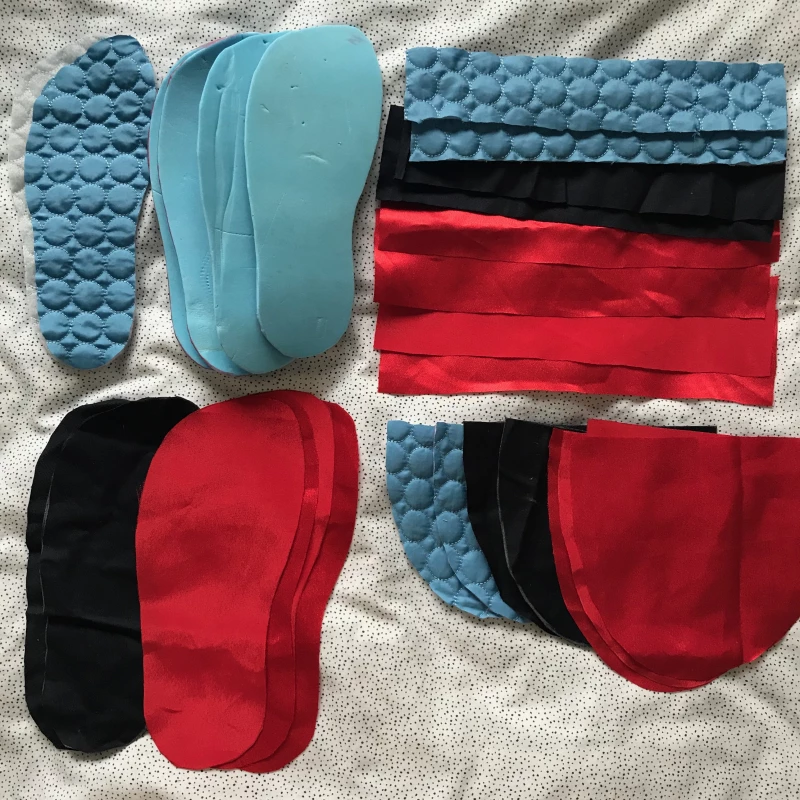

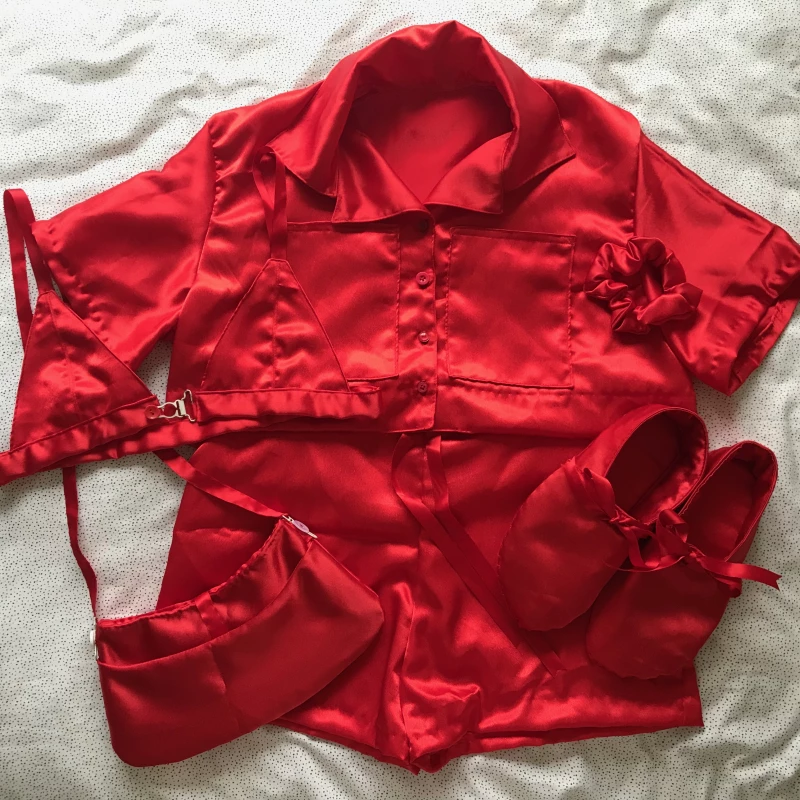
Q: Why does extending the life of materials matter to you?
A: As someone who has always hoarded fabrics and other materials, I know that buying new materials should always be a last resort. There are already so many textiles sent to landfill or 'down-cycled' into cloths and wadding, so we don't need to produce more! The environmental effects of mass textile production - as well as the effects on the people at the start of the supply chain - are terrifying. It's amazing how creative people can be when they choose to use what is already around them, and it's something that we should all try to do more often.
Q: How does this value sit in your everyday life and also in your design work?
A: In my personal life, I try my best to reuse whatever I can before resorting to recycling. A lot of my clothes are hand-me-downs from friends and family, and about half of my mum's wardrobe is my old clothes! Whenever neighbours are chucking out old clothes or textiles, I always have first dibs, so my fabric stash is huge but very useful. In my design work, I try to use only natural or second-hand materials and always design with durability and functionality in mind. It's important to design clothing which is special, making users want to look after and mend it, and even pass it down to their children.
Nina Y @ninaninawhy
A special shout out to Nina for the use of found hair in this pincushion. After having a massive sort out of craft materials, Nina came across this exquisite pincushion using scraps from a 1990's dress (handed down from her sister) that was awaiting stuffing, and simultaneously stumbled on a plastic bag of her own hair - so she thought, why not? Combining the hair with kapok (from Green Fibres), the pincushion came to prickly life like old school horse hair upholstery and tailoring. It's also worth mentioning that the purple felt square in the centre was cut from an old shrunken sock, and the embroidery threads from her stash, "which was previously someone else's thread stash that I bought on Ebay".
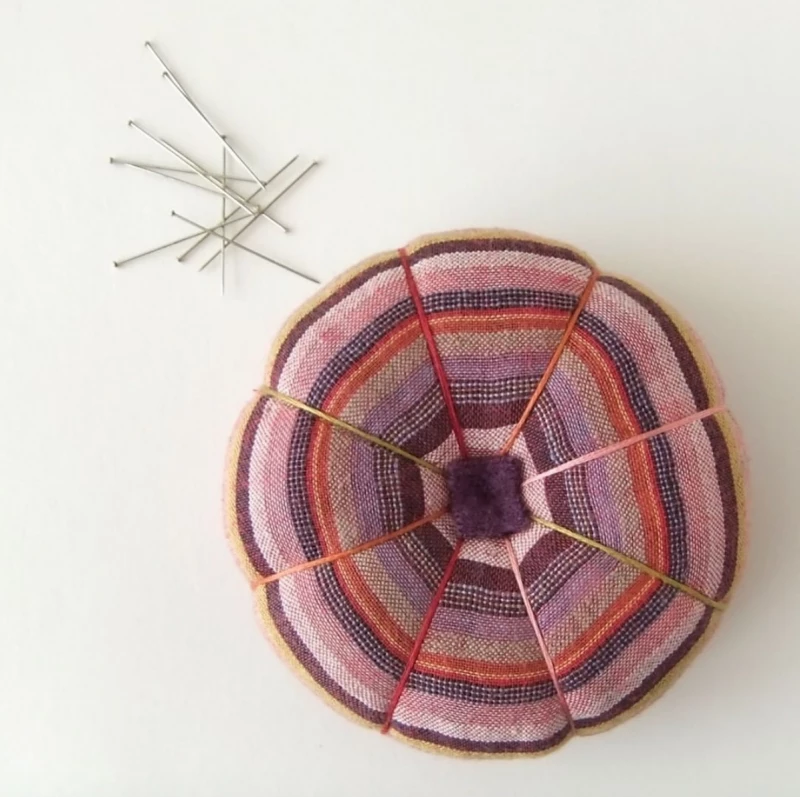
Q: Why does extending the life of materials matter to you?
A: I know that the most sustainable materials available are the ones we already have. I like to think of it as sustaining things. I'm also terribly sentimental: I get really attached to things, even ones that aren't that special, and I hate to ever throw anything away. This partly means that my tiny flat is overflowing with old clothes and other things that I've saved, things that other people would have chucked out long ago... So I'm working on finding a balance, and trying to get better at identifying what really will come in handy, and can be made into something new that's both useful and beautiful, and what I should let go of.
For me, there's a delight in making something functional and attractive out of what others might have thrown away. I prefer to come at this from an angle of what's needed (or wanted), and then work out how I can make it using what I have; I'm not such a fan of many 'upcycling' or 'recycling' projects that seem to come the other way, from looking for something to do with waste materials - that often seems to result in decorative items that don't really serve any purpose.
If you're interested in learning about more businesses that utilise unwanted materials for their products, see our interviews and lessons with: Kapdaa, UseDem, Linda Thomas, and Indosole.
